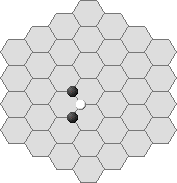There was a thread a while back about alternative tilings for go (viewtopic.php?f=45&t=1163&hilit=hexagon&start=20).
I was thinking about this again, and I like the trihexagonal tiling:
Attachment:
game2.png [ 49.43 KiB | Viewed 16579 times ]
Can you spot the snapback?
This has the nice property that each point has 4 liberties, and it's uniform. Also it seems like 6 stones make life in the corner:
Attachment:
twoeyes.png [ 31.8 KiB | Viewed 16579 times ]


